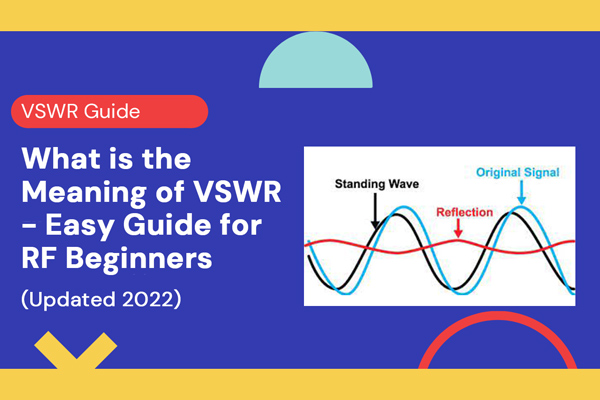
VSWR has always been one of the most important parameters in RF systems because it reflects the efficiency of the whole RF system.
If you are operating a radio station, then you must be concerned about the connection between the antenna and the feeder, because only if they are well matched, will they make your radio station broadcast with the highest efficiency or lowest VSWR.
So, what is VSWR? Fortunately, despite the complexity of VSWR theory, this article can explain the concept and what you need to know in an easy-to-understand way. Even if you are an RF beginner, you can easily understand the meaning of VSWR. Let's get started!
What is VSWR?
First, we need to know what a standing wave is. Standing waves represent power that is not accepted by the load and reflected back along the transmission line or feeder.
No one would want this to happen, because the appearance of standing waves on behalf of the RF system efficiency is reduced.
And we need to explain meaning of VSWR in terms of calculation, that is the ratio of the maximum value of the voltage on the RF line to the minimum value.
Therefore, it is generally expressed as 2:1, 5:1, ∞:1, etc. Where 1:1 means that the efficiency of this RF system reaches 100%, while ∞:1 means that all the energy radiation is reflected back. It resulted from impedance mismatches along the transmission line.
In order to obtain the maximum power transfer from the source to the transmission line, or the transmission line to the load, be it a resistor, an input to another system, or an antenna, the impedance levels must match.
In other words, for a 50Ω system, the source or signal generator must have a source impedance of 50Ω, the transmission line must be 50Ω and so must the load.
In practice, there is a loss on any feeder or transmission line. To measure the VSWR, forward and reverse power is detected at that point in the system and this is converted to a figure for VSWR. In this way, the VSWR is measured at a particular point and the voltage maxima and minima do not need to be determined along the length of the line.
What is the Difference between SWR and VSWR?
The terms VSWR and SWR appear frequently in the literature on standing waves in RF systems, and many people wonder what the dinstinctions are. And here is what you need:
SWR: SWR stands for Standing Wave Ratio. It describes the voltage and current standing waves that appear on the line. It is a general description of current and voltage standing waves. It is usually used in conjunction with a meter used to detect VSWR.
VSWR: VSWR or voltage standing wave ratio means specifically voltage standing waves set on a feeder or transmission line. The term VSWR is often used, especially in RF design, because it is easier to detect voltage standing waves and, in many cases, the voltage is more important in terms of device breakdown.
All in words, the meaning of VSWR and SWR are the same under less stringent conditions.
How Does VSWR Affect RF Systems?
There are several ways in which VSWR can affect the performance of a transmitter system or any system that may use RF and matching impedance. The following is a brief list of applications:
1. Transmitter power amplifiers can be broken - Increased voltage and current levels on the feedline due to VSWR can damage the output transistors of the transmitter.
2. PA protection can reduce output power - A mismatch between the feedline and the antenna will result in a high SWR, which can trigger circuit protection measures that can lead to a reduction in output, resulting in a significant loss of transmit power.
3. High voltage and current levels can damage the feedline - High voltage and current levels caused by high VSWR can cause damage to the feedline.
4. Delay caused by reflection can lead to distortion - When a signal is mismatched and reflected, it is reflected back to the source and can then be reflected back to the antenna again. The introduced delay is equal to twice the signal transmission time along the feed line.
5. Signal reduction compared to a perfectly matched system - Any signal reflected by the load will be reflected back to the transmitter and can be made to reflect back to the antenna again, causing signal reduction.
Conclusion
In this article, we know the definition of VSWR, the difference between VSWR and SWR, and how VSWR affects RF systems.
With this knowledge, although you can't completely solve the problems you may encounter with VSWR, you can have a clear idea about it and try to avoid the damage it may bring you.
If you want to know more about radio broadcasting, follow us!